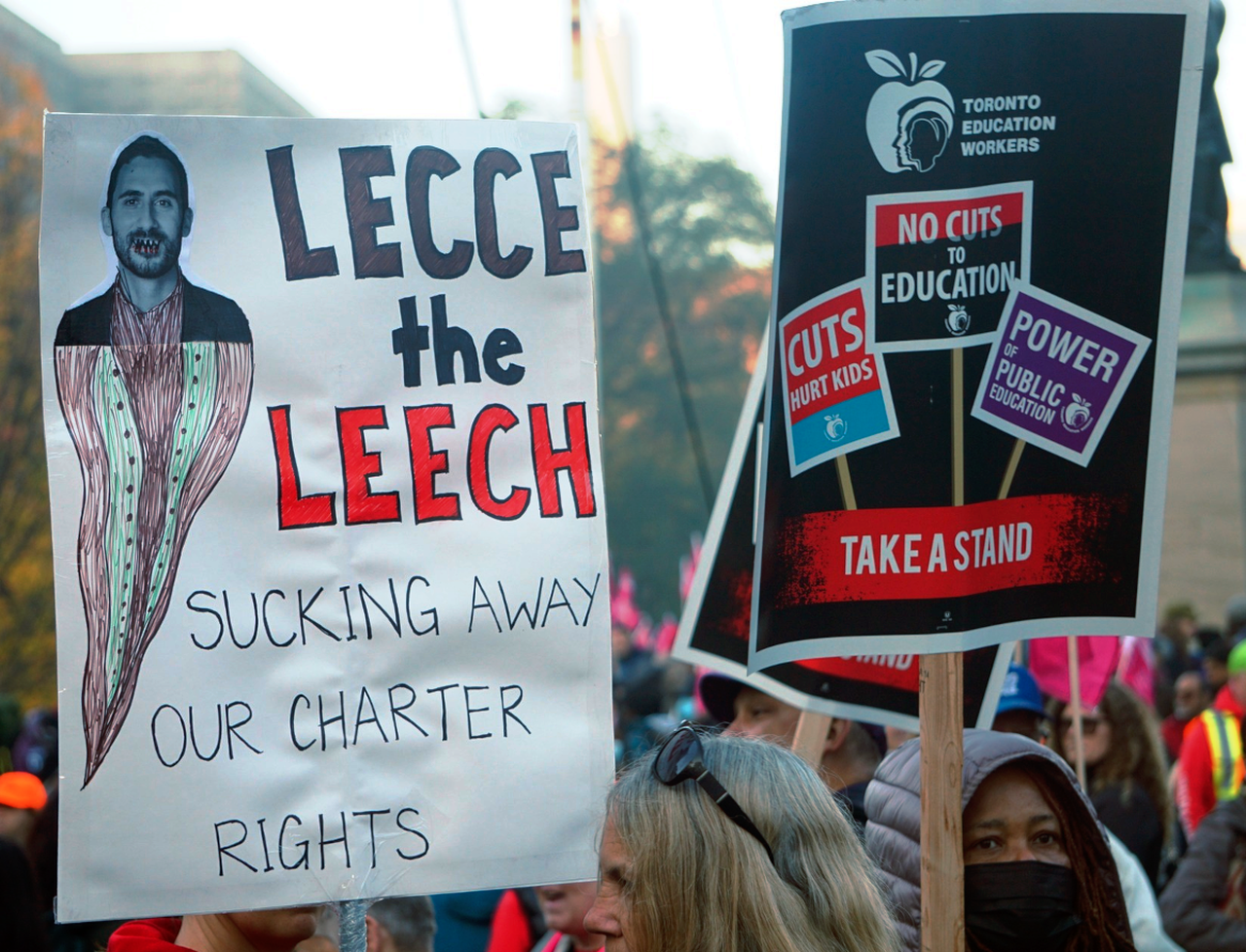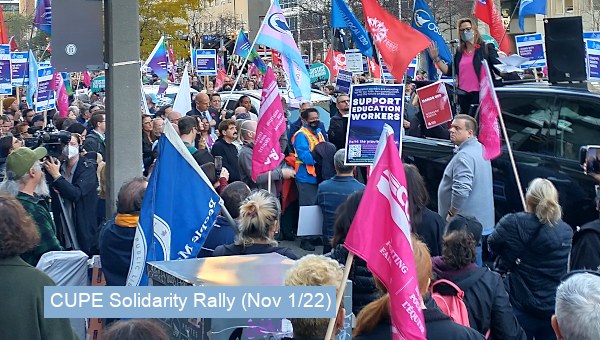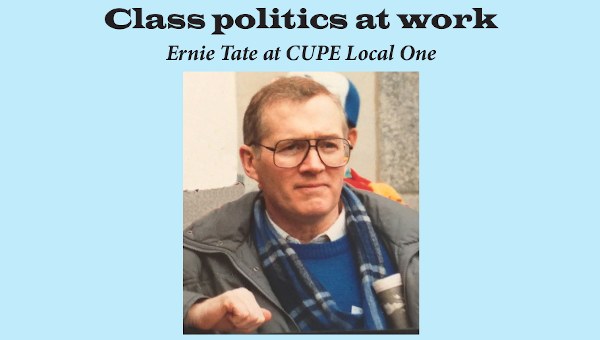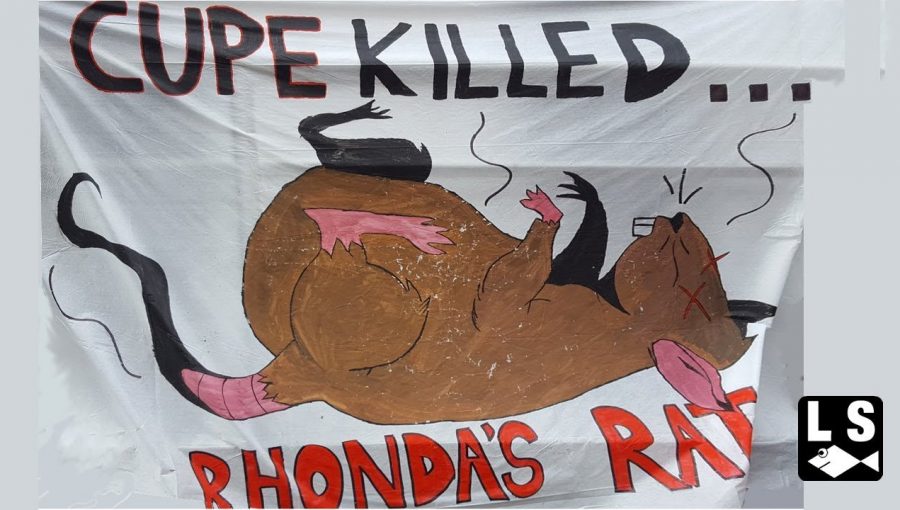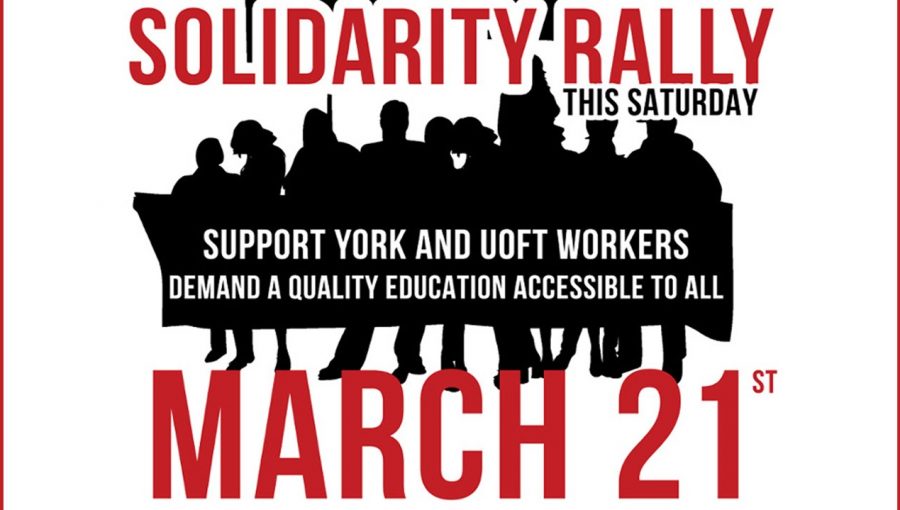Ford, CUPE, Class Struggle and the Charter: A Primer
Why do workers strike? In Canada, our fundamental political economic premise is that, if all individuals decide for themselves how to deploy their resources and talents, the best use will be made of our combined resources and talents. Our law, therefore, promotes individual autonomy and choice. However, this wealth-creation model has a built-in problem. Talents are randomly distributed in a population; resources are not. A very small number of individuals own most of the assets. Those with assets, with wealth, have a real choice as to when, where, how much, for how long they will invest their wealth to further their own interests. They have a choice not to invest it at all. They can survive, very well in fact, while not using their wealth to produce goods and services so as to earn more wealth. This gives them clout when they look for individual workers who have no property to fall back on, who must invest, i.e., sell, their only resource: their physical and intellectual talents and capacities.
This is why workers form unions. It enables them to say to employers that they won’t get the help they need to accumulate more wealth unless they give workers a better deal. Workers need the right to strike to off-set the power of the capitalist class. The capitalists’ power depends on their unchallenged right to withhold their capital, or capitalists’ unchallenged right to strike.
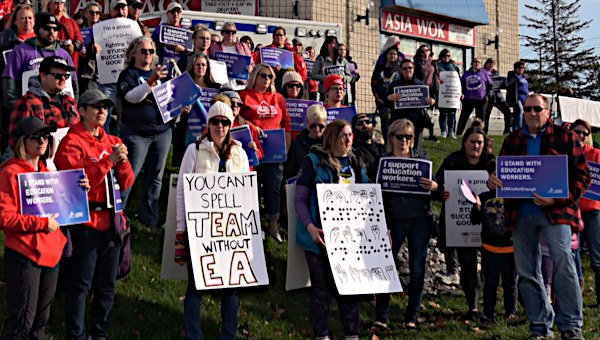
The Workers’ Right to Strike
It has taken the working class a very long time to win a very limited legal right to strike. Employers have had the law firmly on their side. The common law, developed and enforced by the judges, is crafted (i), to protect private property ownership, (ii), to propagate and enforce the ideology of the sovereignty of the individual and the downgrading of collectivism, and (iii), to embed the principle that a solemn agreement reached between legally (not factually) equal individuals, must be enforced as it stands.
Guided by these principles, courts rejected collectivism and enforced inequitable contracts between individual employers and individual workers. They treated attempts to unionize as vicious anti-social behaviour that had to be stopped. Workers fought for legislative relief from this brutal legal oppression. Each time they won some reprieve, courts found loopholes in the worker-protecting legislation and helped employers to avert the impact of unionization. Unions and workers were punished and halted in their tracks. They had to push legislators to close the loopholes found by the capitalism-favouring judiciary. It was not until 1944, ten years after the supposedly more reactionary US had done so, that our Canadian legislatures gave unions limited legitimacy and some circumscribed rights to strike. It was not until 2015 that our Supreme Court declared that permitted collective bargaining included a right to strike. Even now, however, this right does not signify that workers can down tools whenever something annoys them.
While there are some modifications, the basic trade unions’ strike rights are founded on the notion that a union may bargain for, and organize a strike of, workers employed by one employer. In essence, the legalized scheme is one which restricts collective bargaining to employer-by-employer bargaining. The legalized right to strike is, in principle, limited to winning terms and conditions for an identified number of employees at one workplace. Workers are not allowed to use their collective power to force an intransigent employer to recognize and deal with their chosen union. Workers cannot use their collectivized power to help other vulnerable people who are being oppressed socially, politically, economically. Workers represented by a recognized union may not use their strike power when they believe that employers are mis-interpreting and mis-applying existing conditions or terms of an existing collective agreement, even though that collective power was used to obtain those terms and conditions in the first place. They must submit their dispute to a slow, costly, and formalized adjudicative process which eats up a lot of a union’s resources.
More, the union is required to assist employers in educating workers on how to behave; they are expected to squash spontaneous workers’ rejection of employer practices. Unions are, in fact, an integral component of the discipline and punish regime. In the end, they can only use the right to strike when negotiating an agreement and then only after meeting a set of formidable delays, notices, vote-taking, all of which give employers time and opportunity to prepare and plan so as to blunt the use of the strike weapon.
By contrast, the respect for the ownership of invested capital leads the law to protect the managerial prerogative of employers. They may exercise their discretion on how to apply the terms and conditions of an existing collective agreement. Eventually, they may be found to have exceeded their rights under the contract, but until then, they are free to exert their residual managerial powers. And employers may, as individual workers may, always remove their invested property or refuse to continue to invest (often done when they want to force governments to give them a subsidy). Their right to use the strike of capital is not impeded. Their clout to influence governments is not impeded.
Right to Strike in the Public Sector
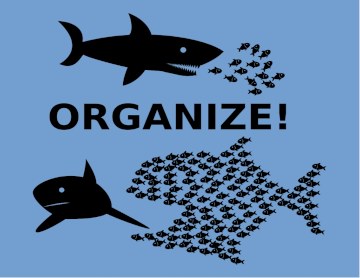
The right-to-strike principles described above are based on the agreement that voluntarily bargained-for contracts should be enforceable, even though they are the outcome of bargaining in a re-structured market, one in which workers may, to some extent, combine. It is based in principle, as is individual contract-making, on the perceived virtue of all persons striving to satisfy their own needs and interests. They are not supposed to take responsibility for the welfare of others.
It is more than a little curious that this model of bargaining has been adapted to apply to the public sectors. After all, one party, the governments, are quite unlike all private self-centred actors in the private sector. They are not seeking to accumulate more wealth; they are not pursuing profits. Government decisions about how to allocate resources, how to set work conditions, are political decisions rather than narrow economic ones. Any dispute they have with their workers over terms and conditions affect the political and policy decisions made by the government. The logic of bargaining about employment conditions ought to be different. A paradox comes into view.
In the private sector, unions cannot use any of the legal powers they have won to get social and political change. They can only use them to gain improvements in conditions and terms for the certified bargaining units on whose behalf they act. More, the employers in this employer-by-employer setting are not in a position to respond to social and political claims. In the public sector, where the Canadian Union of Public Employees-Ontario (CUPE) finds itself, all the collective workers’ demands are easily categorized as demands made by a specific group of workers trying to serve their own interests at the expense of the public as a whole. In short, in contrast to the private-sector model operation, all employer-employee conflicts are overtly political in nature. It is government which has the task to look after the public welfare. It can righteously claim that democratically reached decisions and allocations should be immune from such self-interested claims. The consequence is that the right to strike developed for the for-profit sectors needs to be distorted to apply in the public sector. And so it is.
In the public sectors, many workers are designated as essential workers, that is, as not entitled to participate in a strike. Some workers may be designated as a particular dispute develops, affecting the sway of the workers in the on-going negotiations. In various jurisdictions, some terms and conditions are exempted from the scope of collective bargaining altogether. And, of course, it always makes sense to a harassed government to order striking public sectors engaged in a legal strike to ‘just stop it’. They will enact back-to-work-legislation on terms that applied before the strike began or on new terms or on terms that are to be set by an arbitration board of some sort.
The argument by the government is always the same. As guardians of the public interest, they feel compelled to relieve the hardships inflicted by a small group of self-seeking workers. [It is never said that, if the government gave the workers what they were seeking, the public suffering would stop instantly!] Manifestly, the right to strike in those cases is acknowledged to be one which is not so much a right as a temporary, retractable privilege. This is all the more so because resorting to back-to-work legislation, as Panitch and Swartz documented, is a bit like COVID: a veritable industrial relations plague. Nevertheless, governments of every stripe, including the NDP, have used such legislation, over and over again, in fact, so much so that Canada is considered a world leader by the International Labour Organization (ILO) when it comes to lack of respect for the right to strike. Inasmuch as, without the persistence of public sector unions, there would hardly be any unions at all in Canada, it is clear that talk about the existence of a robust right to strike in Canada is mythological.
Ford’s Gambit and CUPE’s Plight
The Doug Ford government is a collection of crude and brutal neoliberals. Their actions since they have been in power provide the evidence. One of their initiatives was to freeze public sector workers’ wages to a maximum of 1% annual increases (after they had given much larger wage increases to the police and, later, a $16,500 raise to 73 of 83 Conservative MPP’s by elevating them all to be Parliamentary Assistants). CUPE, whose members had borne the brunt of these anti-worker measures, made completely understandable demands for a better deal. Instantly, the Ford government reached out for what is now the customary response by governments throughout Canada. Back-to-work legislation was enacted. With more venom than usual.
Ford and his gang did not want to take a chance on arbitration as it thought it probable that any objective adjudicator would look favourably upon workers who have been royally screwed for years. So, they set the terms and conditions of work according to which workers would be forced to work. More, failure by the union or any of the workers to comply with the back-to-work legislation (passed of course to protect school children!) would result in horrendously punitive fines. Adam King has calculated that the maximum fine of $4,000 per day on a worker would amount to 10% of the average education workers’ annual wage.
And Ford did not stop there. He wanted to ward-off legal blowback. This was in the cards because after the Supreme Court of Canada had declared in 2015 that the Charter-protected freedom of association did after all (after years of denying this!) bestow a right to strike, it was plausible that the restrained CUPE might be able to persuade a court that the back-to-work legislation took away the constitutionalized right to strike and force the government to recompense the workers. Something similar had been experienced by the BC government and, earlier, by the Ontario Liberal government who had, just as nastily as Ford, put a freeze on teachers. So, the Ford bill provided that, whatever a court might want to do about protecting CUPE’s right to strike, it would not matter. Ford’s law invokes the famed notwithstanding clause, S. 33 of the Charter of Rights and Freedoms. A poison pill had been inserted into the back-to-work legislation. It has made many people bilious.
Notwithstanding
Section 33 of the Charter is crafted to deal with the case where a government law or action is found by a court to have infringed on one of the freedoms guaranteed by the Charter. After such a judicial finding, the law or action would be invalid. The government could then, in turn, invalidate the court’s pronouncement by invoking S. 33. It provides that, whatever a court may think, the government’s law should stand. Ford did not wait for a court to rule on his back-to-work legislation. That legislation stated that it was valid notwithstanding any possible ruling by a court.1 Don’t monkey with me, said Ford.
It should be noted here that the notwithstanding clause was essential to the passing of the Charter. While some of those who insisted on the inclusion of S. 33 before they signed on to the Charter may have had different motives, the demand that a democratically elected government should have the capacity to insist that its decisions could not be thrown aside by an unelected, appointed court, had merit. It was an acknowledgment that popular will, as reflected by an elected government, had to be respected. During the heat generated by the Ford use of S. 33 this tends to be a marginalized idea.
The hatred evinced at the use of S. 33 by Ford is because its use is seen as eviscerating the much-beloved guarantees of freedoms specified in the Charter. What disappears from view is that Section 33 is just as valid a provision in the Charter as are the clauses safeguarding certain freedoms. Indeed, it is there to protect another cherished principle, the right of democratically elected governments to determine how they should govern. It is arguable that it may not be, in the end, very good politics to fight for the right of the judiciary to be left to decide unimpededly how important social and political rights should be defined and protected.
This point, given the historic anti-working-class bias of the judiciary in common law jurisdictions, should have some resonance for those who fight for workers’ rights. It is something of a paradox that workers are now being driven to rely on the courts to defend rights that the courts did their best to deny them for eons, even when the courts were first asked to define the freedom to associate as guaranteed by the Charter. But this debate can wait for another day. There is a more salient point to make about Ford’s use of S. 33 to Charter-proof his draconian back-to-work legislation.
The notwithstanding clause, a potential tool to deepen democratic practices, is being used, or should we say abused, by a profoundly anti-democratic government. Ford and his gang are not content with stopping CUPE from using their strike rights as the law permits, but instead, they are intent on showing that workers and their unions should remain submissive, should not act as if they were sovereign citizens. Ford’s use of the notwithstanding clause is not meant to advance democracy but to show that workers and their unions have no rights. Workers exist just to be available to capitalists as they drive to accumulate socially produced wealth. That’s it. Like US President Ronald Reagan when he attacked and demolished PATCO and UK Prime Minister Margaret Thatcher when she set out to destroy the coal miners and, somewhat less spectacularly, like the Canadian government when it took on Jean-Claude Parrot and the post office workers, Ford is saying, ‘We run things; you do as you are told.’
His use of notwithstanding thus becomes a declaration that he is engaged in class war. The legal niceties do not matter. He has unleashed a weapon of mass destruction. The right response is for CUPE, and all those who want to support them, to fight the fight in the same spirit. It is time to show the dominant class that without workers, they would not have anything, that workers take the risks and should have a real say over their lives. The ugly Ford has given us all an opportunity to see and say out loud that the rights to bargain collectively and to strike in Canada, are very limited and all too easily taken away whenever the Fords of this world detect a weakness and bare their fangs.
Go CUPE, go. •
